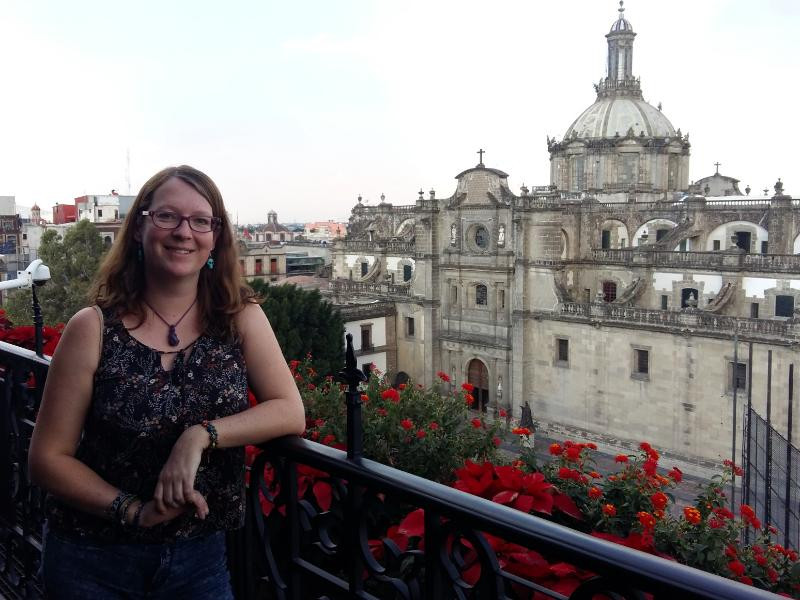Is Mexico City safe for solo female travelers? At gaymexico.net, we understand that safety is a top concern for LGBTQ+ individuals planning a trip to Mexico. Mexico City, a vibrant and culturally rich destination, can be an incredible experience with the right knowledge and precautions. This guide provides you with detailed insights, practical tips, and resources to ensure a safe and enjoyable journey, empowering you to explore Mexico City with confidence. With our guide, you’ll find everything you need to know to feel secure and comfortable while experiencing the best of Mexico City’s LGBTQ+ scene, cultural landmarks, and culinary delights.
1. Understanding Safety in Mexico City for Solo Female Travelers
Is Mexico City safe for solo female travelers? Overall, Mexico City can be safe for solo female travelers if you take necessary precautions and stay informed.
Mexico City, like any major metropolis, has areas and situations that require extra vigilance. However, by understanding the risks and taking proactive steps, solo female travelers can have a rewarding and safe experience. According to research from the UCLA Williams Institute, LGBTQ+ travelers are more concerned about safety than non-LGBTQ+ travelers, so it’s wise to be prepared and cautious.
1.1. What are the General Safety Tips for Solo Female Travelers in Mexico City?
General safety tips include staying in well-known areas, avoiding poorly lit streets at night, and not displaying expensive jewelry.
Being aware of your surroundings is critical. Avoid walking alone late at night, especially in less populated areas. Keep your valuables out of sight and be mindful of your belongings in crowded places like markets and public transport. Trust your instincts; if a situation feels unsafe, remove yourself immediately.
1.2. What are the Safest Neighborhoods for Solo Female Travelers?
The safest neighborhoods often cited are Roma, Condesa, and Polanco, known for their vibrant atmosphere and safety.
These neighborhoods are popular with tourists and expats, offering a mix of cafes, restaurants, and boutiques. They are generally well-lit and patrolled, making them safer for walking around, even at night. However, it’s still important to remain vigilant and aware of your surroundings.
1.3. What Areas Should Solo Female Travelers Avoid?
Avoid areas like Tepito, Doctores, and certain parts of Iztapalapa, known for higher crime rates.
These areas are generally not tourist-friendly and can be dangerous, even during the day. It’s best to avoid them altogether. If you’re unsure about an area, ask locals or your hotel staff for advice.
1.4. What are the Transportation Safety Tips for Solo Female Travelers?
Use reputable transportation services like Uber or the Metro’s women-only carriages, especially at night.
Uber is a safe and reliable option because you can track your ride and share your location with friends or family. The Mexico City Metro also has women-only carriages during peak hours, providing a safer and more comfortable commute. When using taxis, make sure they are official and licensed.
1.5. How Should Solo Female Travelers Handle Interactions with Locals?
Be polite but firm in your interactions, avoid sharing too much personal information, and trust your instincts.
Most Mexicans are friendly and helpful, but it’s important to maintain a level of caution. Avoid engaging in lengthy conversations with strangers, especially if they make you uncomfortable. If someone is too persistent, politely excuse yourself and move away.
2. LGBTQ+ Specific Safety Advice for Mexico City
Mexico City is known for its progressive attitudes, yet LGBTQ+ travelers should still be aware and cautious.
While Mexico City is generally accepting, public displays of affection may attract unwanted attention in more conservative areas. According to Human Rights Watch, LGBTQ+ individuals in Mexico still face discrimination, so it’s essential to stay informed and vigilant.
2.1. What are the Legal Protections for LGBTQ+ Travelers in Mexico City?
Mexico City has legalized same-sex marriage and offers protections against discrimination based on sexual orientation.
These legal protections provide a degree of security, but it’s still important to be aware of local attitudes, which can vary. Knowing your rights can help you feel more confident and secure during your travels.
2.2. Where are the Most LGBTQ+-Friendly Areas in Mexico City?
Zona Rosa is known as the city’s gay neighborhood, offering a safe and welcoming environment.
Zona Rosa is home to numerous gay bars, clubs, and restaurants, making it a hub for LGBTQ+ nightlife. The area is generally safe and accepting, but it’s still wise to be cautious, especially late at night.
2.3. What Should LGBTQ+ Travelers Do if They Experience Discrimination?
Report incidents to local authorities and seek support from LGBTQ+ organizations.
If you experience discrimination, you can file a report with the local police or the National Council to Prevent Discrimination (CONAPRED). Several LGBTQ+ organizations in Mexico City can provide support and assistance.
2.4. How Can LGBTQ+ Travelers Stay Informed About Local Events and Safety Alerts?
Check local LGBTQ+ websites and social media groups for up-to-date information.
Stay informed about any safety concerns or events that may affect LGBTQ+ travelers. Local LGBTQ+ websites and social media groups can provide valuable information and updates.
2.5. How to Find Safe and Welcoming Accommodations for LGBTQ+ Travelers?
Use LGBTQ+-friendly travel websites and look for accommodations with inclusive policies.
Several travel websites specialize in LGBTQ+ travel, offering reviews and ratings of hotels and accommodations. Look for accommodations that have inclusive policies and are known for welcoming LGBTQ+ guests.
3. Practical Tips for Staying Safe in Mexico City
Staying safe involves practical measures that apply to all travelers, with extra attention to detail.
From securing your belongings to staying connected, these practical tips can help you minimize risks and enjoy a worry-free trip.
3.1. How to Secure Your Belongings?
Use a concealed money belt, avoid displaying expensive jewelry, and keep your phone out of sight when not in use.
Pickpocketing is common in crowded areas, so it’s important to keep your valuables secure. A money belt or hidden pouch can help protect your cash and cards. Avoid flashing expensive items that could make you a target.
3.2. How to Stay Connected?
Purchase a local SIM card or use a portable Wi-Fi device to stay connected and access maps and emergency services.
Having access to the internet is essential for navigation, communication, and accessing emergency services. A local SIM card or portable Wi-Fi device can provide reliable connectivity.
3.3. How to Use Transportation Safely?
Stick to Uber, authorized taxis, or the Metro’s women-only carriages, especially at night.
These transportation options are generally safer and more reliable. Avoid unmarked taxis or accepting rides from strangers.
3.4. How to Navigate Crowded Areas?
Be extra vigilant in crowded tourist spots, markets, and public transportation.
Crowded areas are hotspots for pickpockets. Keep your bag close to you, and be aware of people around you. Avoid getting distracted by your phone or other devices.
3.5. How to Handle Alcohol and Parties Safely?
Drink responsibly, never leave your drink unattended, and avoid going home alone with someone you just met.
Partying can be a fun part of your trip, but it’s important to stay safe. Be mindful of your alcohol consumption, and never leave your drink unattended. Avoid walking home alone, and use a taxi or Uber.
4. Must-See Attractions in Mexico City for Solo Female Travelers
Mexico City offers a wealth of attractions that are perfect for solo exploration.
From historical sites to cultural experiences, these must-see attractions offer something for everyone.
4.1. What are the Best Historical Sites to Visit?
Explore the Templo Mayor, Palacio Nacional, and the historic center for a deep dive into Mexican history.
These sites offer a glimpse into Mexico’s rich past. The Templo Mayor was the main temple of the Aztec capital, while the Palacio Nacional houses stunning murals by Diego Rivera. The historic center is a UNESCO World Heritage site with beautiful architecture and cultural landmarks.
4.2. What are the Top Cultural Experiences?
Visit the Frida Kahlo Museum, Palacio de Bellas Artes, and explore local markets for an immersive cultural experience.
The Frida Kahlo Museum offers a personal look into the life of the iconic artist, while the Palacio de Bellas Artes showcases Mexican art and culture. Local markets provide a taste of everyday life in Mexico City.
4.3. Where are the Best Parks and Green Spaces?
Relax in Chapultepec Park, explore the Bosque de Tlalpan, or visit the Xochimilco canals for a break from the city.
These parks and green spaces offer a peaceful escape from the hustle and bustle of Mexico City. Chapultepec Park is one of the largest urban parks in the world, while the Xochimilco canals offer a unique experience with colorful boats and floating gardens.
4.4. What are the Culinary Hotspots?
Sample street food in Roma Norte, dine in Condesa’s restaurants, or visit Mercado San Juan for gourmet treats.
Mexico City is a culinary paradise, offering a wide range of dining options. Roma Norte and Condesa are known for their trendy restaurants, while Mercado San Juan offers a variety of gourmet treats and exotic ingredients.
4.5. Where to Enjoy the Nightlife?
Experience the vibrant nightlife in Zona Rosa or explore the trendy bars in Roma and Condesa.
Zona Rosa is the heart of Mexico City’s LGBTQ+ nightlife, while Roma and Condesa offer a mix of bars and clubs for all tastes. Be sure to stay vigilant and use safe transportation options.
5. Resources for LGBTQ+ Travelers in Mexico City
Having access to reliable resources can enhance your safety and overall travel experience.
From emergency contacts to LGBTQ+ support organizations, these resources can provide assistance and information when you need it.
5.1. What are the Emergency Contact Numbers?
Keep numbers for the police, ambulance, and your embassy readily available.
In case of an emergency, it’s important to have the right contact numbers at hand. The general emergency number in Mexico is 911.
5.2. Which LGBTQ+ Organizations Can Provide Support?
Identify local organizations that offer assistance and resources for LGBTQ+ travelers.
Organizations like All Out and Cuenta Conmigo can provide support and resources for LGBTQ+ travelers in Mexico City.
5.3. Where Can You Find Travel Advice and Safety Alerts?
Check travel advisories from your home country and local news sources for up-to-date information.
Stay informed about any safety concerns or travel advisories issued by your government. Local news sources can provide updates on current events and potential risks.
5.4. How to Connect with the Local LGBTQ+ Community?
Join social media groups and attend local LGBTQ+ events to connect with the community.
Connecting with the local LGBTQ+ community can enhance your travel experience and provide a sense of belonging. Social media groups and local events are great ways to meet people and learn about the city.
5.5. What are the Essential Spanish Phrases for Safety and Assistance?
Learn basic phrases for asking for help, reporting incidents, and understanding directions.
Knowing a few basic Spanish phrases can be incredibly helpful in case of an emergency. Phrases like “Ayuda” (Help), “Policía” (Police), and “¿Dónde está…?” (Where is…?) can be invaluable.
6. Addressing Common Concerns of Solo Female Travelers
Addressing these concerns can provide reassurance and empower you to explore Mexico City confidently.
Understanding the realities and having strategies to manage potential issues can make your trip more enjoyable.
6.1. What is the Risk of Petty Theft?
Petty theft is common in tourist areas, so take precautions like using a money belt and staying vigilant.
Pickpocketing and bag snatching are common, especially in crowded areas. Keep your valuables secure and be aware of your surroundings.
6.2. How to Avoid Harassment?
Dress modestly, avoid walking alone at night, and be assertive in your interactions.
While most Mexicans are respectful, unwanted attention can occur. Dressing modestly and avoiding walking alone at night can reduce the risk of harassment.
6.3. What if You Get Lost?
Use GPS apps, ask for directions from trusted sources, and avoid wandering into unfamiliar areas.
If you get lost, use a GPS app to find your way back. Ask for directions from trusted sources like shopkeepers or hotel staff. Avoid wandering into unfamiliar areas, especially at night.
6.4. How to Stay Healthy?
Drink bottled water, be cautious with street food, and have travel insurance that covers medical expenses.
Mexico City’s tap water is not safe to drink, so stick to bottled water. Be cautious with street food, and choose vendors that look clean and popular. Travel insurance can cover medical expenses in case of illness or injury.
6.5. What to Do in Case of an Emergency?
Stay calm, contact the local authorities, and inform your embassy or consulate.
In case of an emergency, stay calm and assess the situation. Contact the local authorities and inform your embassy or consulate as soon as possible.
7. Personal Stories and Testimonials
Hearing from other solo female travelers can offer valuable insights and inspiration.
These stories can provide a realistic perspective and practical advice based on personal experiences.
7.1. Share Positive Experiences from Other Solo Female Travelers
Highlight stories of women who have had safe and enjoyable trips to Mexico City.
Sharing positive experiences can help reassure other women that Mexico City can be a safe and rewarding destination.
7.2. Discuss Challenges and How They Were Overcome
Address common challenges faced by solo female travelers and how they were resolved.
Discussing challenges and how they were overcome can provide practical advice and help women prepare for potential issues.
7.3. Include Tips and Recommendations from Experienced Travelers
Gather tips and recommendations from experienced solo female travelers for staying safe and enjoying the city.
Experienced travelers can offer valuable insights and tips based on their personal experiences.
7.4. What Kind of Advice Would You Give to a First-Time Solo Female Traveler?
Highlight some advice: “Be prepared, stay informed, and trust your instincts.”
Being prepared, staying informed, and trusting your instincts are key to a safe and enjoyable trip.
7.5. How Can Solo Female Travelers Make the Most of Their Trip?
Focus on exploring the city’s culture, connecting with locals, and enjoying the freedom of solo travel.
Solo travel offers the opportunity to explore at your own pace and connect with locals. Focus on immersing yourself in the city’s culture and enjoying the freedom of solo exploration.
8. Conclusion: Embrace Your Adventure with Confidence
Mexico City offers a wealth of experiences for solo female travelers, especially those in the LGBTQ+ community. By staying informed, taking precautions, and utilizing available resources, you can confidently embrace the adventure and create unforgettable memories.
8.1. Recap of Key Safety Tips
Remember to stay in safe neighborhoods, use reliable transportation, secure your belongings, and stay connected.
8.2. Encouragement for Solo Female Travelers
Don’t let safety concerns deter you from exploring this vibrant and culturally rich city.
8.3. Call to Action
Visit gaymexico.net for more detailed guides, resources, and community support to plan your perfect trip to Mexico City!
We invite you to explore gaymexico.net, where you’ll discover a wealth of information, from in-depth travel guides to community forums. You can also find the best spots, connect with fellow travelers, and access the latest safety alerts. Let us help you make your adventure to Mexico City not only safe but also enriching and unforgettable!
8.4. Additional Resources
For further assistance, consider reaching out to the following:
- Address: 3255 Wilshire Blvd, Los Angeles, CA 90010, United States
- Phone: +1 (213) 380-2177
- Website: gaymexico.net
8.5. Final Thoughts
Mexico City is waiting to be explored. With the right preparation and mindset, your solo journey can be an empowering and transformative experience.
Frequently Asked Questions (FAQs)
1. Is it really safe for a woman to travel alone in Mexico City?
Yes, Mexico City can be safe for solo female travelers who take necessary precautions, such as staying in well-known areas, avoiding poorly lit streets at night, and using reputable transportation services.
2. Which neighborhoods in Mexico City are considered the safest for solo female travelers?
Roma, Condesa, and Polanco are generally considered the safest neighborhoods due to their vibrant atmosphere, well-lit streets, and frequent patrols.
3. Are there any specific areas in Mexico City that solo female travelers should avoid?
Yes, it’s best to avoid areas like Tepito, Doctores, Ciudad Neza, and certain parts of Iztapalapa due to higher crime rates.
4. What is the best way for a solo female traveler to get around Mexico City safely?
Using Uber, authorized taxis, or the Metro’s women-only carriages is recommended, especially at night. Avoid unmarked taxis or accepting rides from strangers.
5. How can solo female travelers protect their belongings from theft in Mexico City?
Use a concealed money belt, avoid displaying expensive jewelry, and keep your phone out of sight when not in use. Be extra vigilant in crowded tourist spots, markets, and public transportation.
6. What should a solo female traveler do if she experiences harassment in Mexico City?
Be assertive, remove yourself from the situation, and, if necessary, report the incident to local authorities or seek assistance from LGBTQ+ organizations.
7. Are there any legal protections for LGBTQ+ travelers in Mexico City?
Yes, Mexico City has legalized same-sex marriage and offers protections against discrimination based on sexual orientation, providing a degree of security.
8. How can LGBTQ+ travelers find safe and welcoming accommodations in Mexico City?
Use LGBTQ+-friendly travel websites and look for accommodations with inclusive policies and positive reviews from other LGBTQ+ travelers.
9. What resources are available for LGBTQ+ travelers in Mexico City if they need assistance?
Local organizations like All Out and Cuenta Conmigo, as well as emergency contact numbers for the police, ambulance, and your embassy, can provide support and resources.
10. What are some essential Spanish phrases that can help a solo female traveler stay safe in Mexico City?
Knowing phrases like “Ayuda” (Help), “Policía” (Police), and “¿Dónde está…?” (Where is…?) can be invaluable in case of an emergency.
 Mexico City at Night
Mexico City at Night

